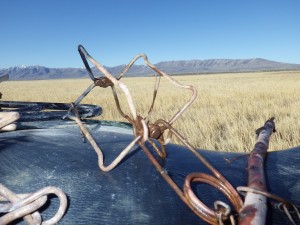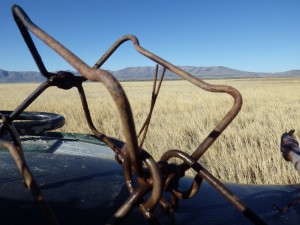Trapping and putting up furs doesn’t end at the trap line. Sure, the trapper has to go out into the field and catch the animals and bring them in, but there is sure a lot more to it then that. We have pulled all our traps and now have a deadline approaching which makes it very important that we get all the furs we put in the freezer during the season out and thawed, dried, combed, fleshed and stretched and adequately cured and ready for the auction. Yesterday was a very full day for Bob and I. We began at 1 p.m. by meeting in the shed. We had laid out the rats the day before in order to thaw and our first order of business was to make sure they were all separated and that the wet ones were put on the drying rack to further dry. As is always the case when you take furs out of the freezer, some of them will be dry enough to put up. We separated them into a big pile while the rest were laid out on the drying rack or otherwise put where they could dry both on the front and the back of the fur. The pile we ended up with that were dry enough to put up was a pretty big pile.
Without counting them we knew we had about 150 that we took out of the freezer and so we knew that we had to take down about 150 from the overhead in the shed. “Taking Down” means, removing some of the dried skins from the hangers and bagging them up. We decided to take down 200 and bag them in lots of 50 per bag. They are ready for the auction and for storage purposes, we put them in a large chest freezer for safe keeping. That freed up hanger space for rats to come down off the stretchers and go on the hangers. The hangers allow the skins to cure a little longer….not that they need it, but why not allow them more time, right?
Our next big decision was how many of the hides on the stretchers should we take down and put on the hangers? We decided we needed enough space for the pile of rats that were dried and ready to be fleshed and stretched and we made a wild guess of about 75 or so were in that pile. So, we took down 100 stretchers and put those hides on the hangers.
These things take time to accomplish and it was after 3 p.m. by the time we began to brush out the hides laying there on the floor. We did what we could in our old and slow way and had about 25 put up on stretchers and beginning the curing process when Weasel arrived…it was right at 4 p.m. With his help, the pile of dry rats soon became a pile of hides turned inside out and waiting to be fleshed…my job.
Fleshing the way I do it doesn’t take a lot of time, but it sure does make my back ache. I bend over a fleshing board to get the job done and even though I’ve tried other methods, I always come back to the one I think gets the job done better. It was about 6 p.m. when the last of the dry and brushed hides went up on the drying line overhead. A long 5 hour day in the shed for Bob and I.
If it wasn’t for Weasels’ help we would have been in there a couple more hours!
Well, today’s schedule is almost the same, except with Weasel willing to help again, we are not meeting in the shed until 4 p.m. to put up the remaining hides. Again, it will require taking down about 100 from the stretchers and putting them on hangers, but we estimate, with three of us we won’t be much past 6 p.m. getting the whole job done.
On a side note, hunting, fishing and other activities come with opportunities that a lot of people don’t think about or recognize that can put a few dollars into their pockets. I have a friend that used to pick ducks and geese for a profit and if you have ever done something like that to make a dollar or two, you know how nasty that job can be. Well, he would save the feathers and especially the down from those birds and would sell the bags to further make his money. Trapping muskrats has a similar money maker hidden in it and we have been capitalizing on that for several years. Male muskrats have glands that produce a musky smell (thus the name Musk…rat) and they swell up pretty large during the Spring time run. There is a pretty good demand for these glands in the “lure making” business and so we save these glands and put them into quart sized jars. Normally we sell them locally, but this year I have contacted a business in Florida that will give us a very good price for them and I’m going to ship our 3 quarts off to him. For you who might also be interested in shipping your glands to him you can give him a call at 239-994-7772. He is really interested in Mink Glands and will pay as much as $250 for a gallon of them, but he wants any and all mink glands he can get. Like he told me, he can’t buy mink or muskrat glands locally…Florida just plain doesn’t have those critters. His business name and address is:
Grandpas Trading Post, 10171 Betsy Parkway, St. James City, Florida 33956
Bears Butt
March 18, 2014


 Utah Fishing Reports
Utah Fishing Reports

Leave a Reply